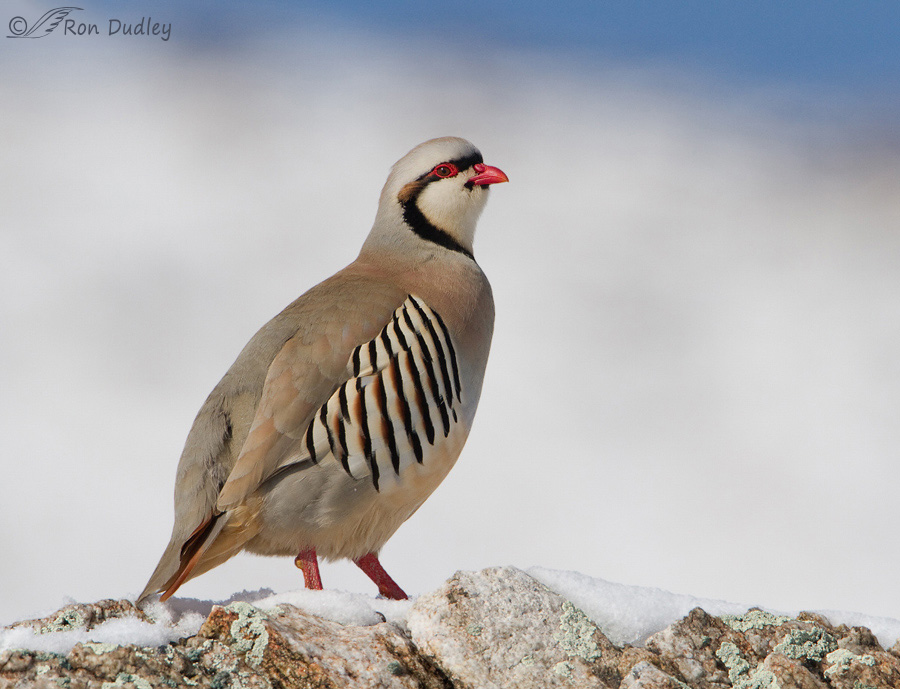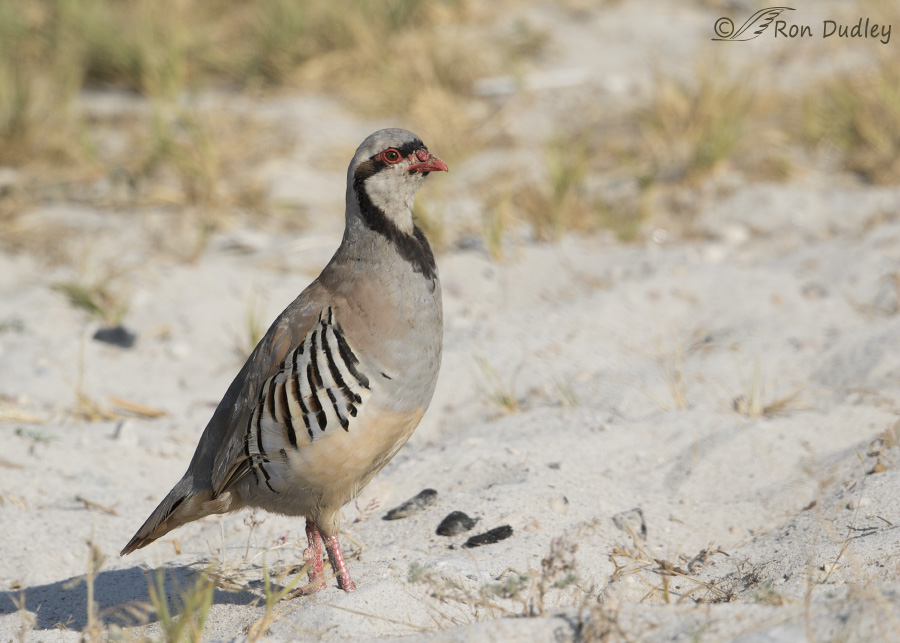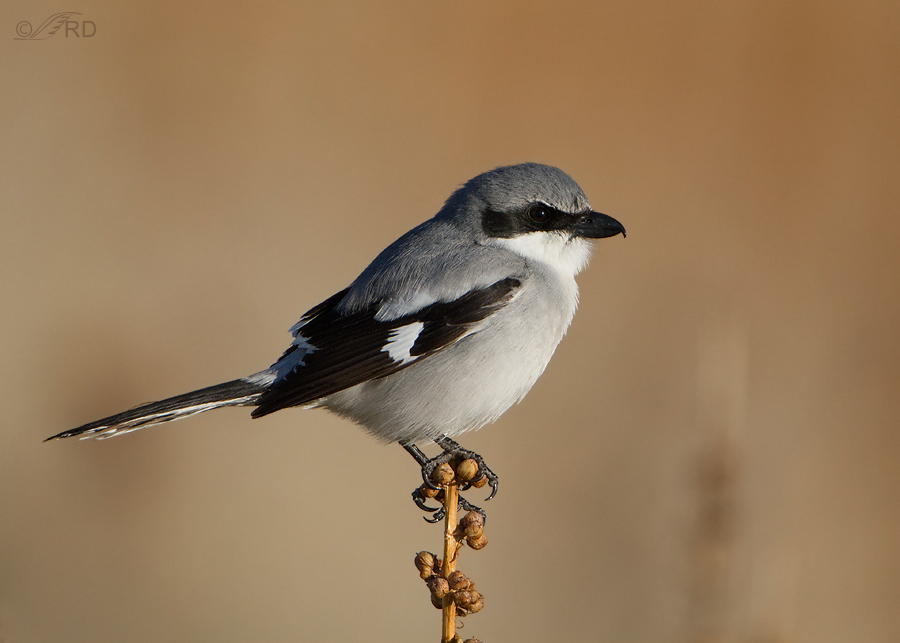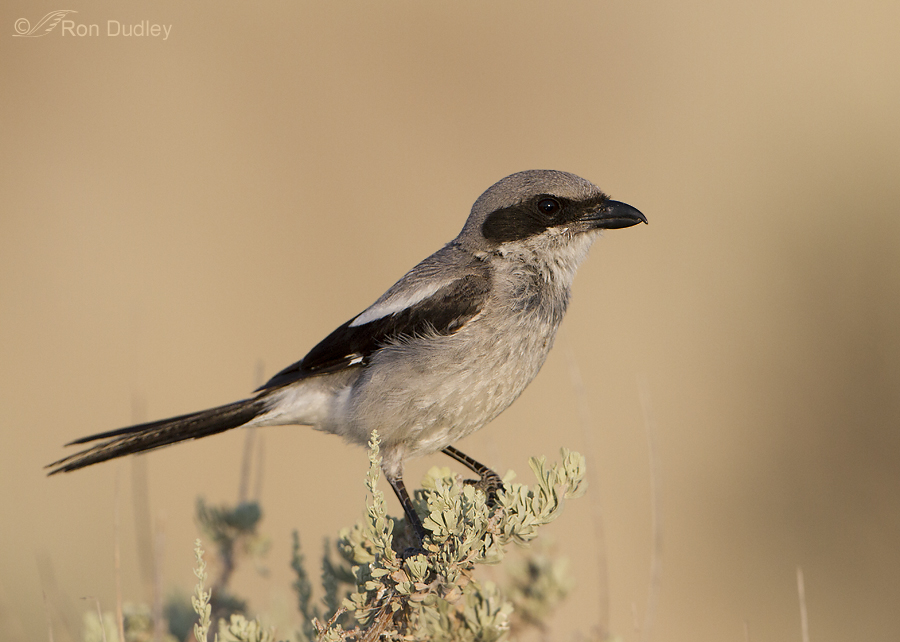I was confused for a long time by this color change in some of our birds.

I first noticed it in Chukars. During winter and spring the soft, creamy colors of Chukars are particularly attractive and I love photographing them in those seasons. I found this one in early spring a few years ago and I’ve always enjoyed the creamy colors of the bird set against the snow and blue sky background. This is what Chukars look like for much of the year.

But beginning in about mid-summer they become dingy-looking and darker. Their lighter colors become splotchy – it’s particularly noticeable in the whites of the lower face and throat which become dark and dirty-looking. I photographed this one a couple of days ago as it strutted through the oolitic sand near the beach of Antelope Island.

A similar color change occurs in our Loggerhead Shrikes. In winter and spring their whites and light grays are pure and attractive and I really enjoy photographing them that time of year. This image was taken in April.

But by mid-summer this is what most of the adults look like – the whites and light grays have become dark and splotchy (this image was taken in July).
When I’d look in field guides and other sources to try to account for these color changes I always came up empty. For a while I wondered if their plumage was simply becoming soiled and dirty. But eventually my friends Brian Gatlin and Bryce Robinson (both serious students of birds) provided the explanation.
As older feathers of some species become worn they “wear to dark”. Feathers overlap (especially contour body feathers) and we usually mostly see only their edges. The feathers of many species have darker bases than edges (this can be seen on individual feathers we might find on the ground) so as the lighter outside edges wear away the darker interior colors become exposed and that’s what we see. When those older feathers are replaced and molt is complete the original colors of the bird are restored.
I’ve noticed the phenomenon mostly in shrikes and Chukars but Bryce has seen it in Common Redpolls and some gulls. There are also other species that exhibit the trait. I mention it now because this is the time of year it becomes most apparent.
Perhaps some readers have seen the same phenomenon in other species.
Ron


Fascinating topic and great examples. I was familiar with things like seasonal breeding plumage, but not this. Great info, thanks! I will have to keep an eye out and look through my older photos.
Great shots and observations Ron!
Charlotte
Thanks, Charlotte.
How fascinating. How completely fascinating. And, with the facts to hand, how completely logical. I will watch, but suspect the plumage of the birds I see most often will make it challenging.
I’m glad you found it interesting, EC. Thank you.
The color changes as the feathers wear are quite striking, and the birds are definitely less attractive in your summer photos. I generally don’t get to spend enough time watching birds closely enough to see such changes, but I can tell you that the Ring-billed and Herring Gulls we’re seeing have absolutely pristine white feathers. I’ve never seen either of those species look grungy.
I don’t think it happens to all birds, Susan. If the individual feathers are mostly monotone you wouldn’t see any color change as they wear.
Very interesting Ron, I sorta noticed when I lived in eastern Or. many years ago. I just thought they were older birds
Thanks, David.
Nicely documented changes.
Plumage wear accounts for color changes in many birds. In the fall, Eurpoean Starlings are covered with light spots. These spots are the light-colored tips of fresh body feathers that grew in during the fall molt. These feather tips gradually wear away and by spring the starling has the shiny, iridescent appearance we know as its breeding condition—not a new coat of feathers, but old, worn feathers. A dramatic change also occurs in White-winged Crossbills. At the completion of the fall molt the males are pinkish in color. There is red pigment in the barbs, but the barbules are clear which makes the body look pink. Through the winter, the barbules gradually become worn leaving the red of the barbs to show more easily. So fall males are pink and these same males in summer are red, all without a molt occuring, just feather wear. Red Crossbill males are always red because both the feather barbs and barbules are red so no change of color is visible as the barbules wear away.
Interesting examples, Dan, especially the crossbills. Thanks for providing them!
I particularly notice this with out Blue Jays….the young are much brighter white and bluer blue than their worn out parentsby the end of the season….
Yup, that’s true in a number of species, Patty.
It’s just cool to learn something new every day, and you provide that opportunity almost every day! I’m sure that parenthood does NOT help this process. But wouldn’t it be cool if we could molt every year?
“But wouldn’t it be cool if we could molt every year?”
Maybe that would actually put some hair on my head!
Interesting observation. My first thought was older feathers getting warn and, perhaps, preparing for molt. Our chickens get that way. Glad you noticed and documented it! 🙂 They sure do look better in the winter/spring photos!
“They sure do look better in the winter/spring photos!”
Yes, they do, Judy. I sometimes feel bad that I often ignore both species this time of year because of their “dinginess” – after all it’s not their fault and it’s a natural transition. On the other hand they probably appreciate the temporary relief from pesky photographers like me… 🙂
Ah-Ha! That explains something I was pondering yesterday Ron as I was photographing a Loggerhead Shrike and thinking that the eye-stripe seemed Huge. I mean really Huge. It was sooo Huge. 🙂
I will have to keep my eye out for this in other species too. Magpies ?
Thanks for the education. This is one of those ones I will always remember while looking at birds. Thanks!
Good! I’m glad you found this info helpful, Ed.
I’ve never noticed this color change in magpies that I remember. Perhaps it’s because their individual feathers are largely the same color their entire length…
Very interesting. If it was not for the “Zorro eyemask” I would say it was a bird from a diferent species.
Thank you for showing those examples.
Yes, they look THAT different when their feathers are worn, Jorge.
Ron:
Thanks. I did not know about “Wearing to Dark.” I will try to post a summer FL bird on your Facebook page.
I’d like to see it, Dave. Thanks.
Wow, Ron – what a difference in both birds – amazing difference!! I have a friend who is a watercolor artist and bird photographer. He is lucky enough to have a Loggerhead Shrike pair who have nested in his yard for the last 3 years and he’s been lucky enough to photograph the full cycle of eggs to fledge for 2 of those years. With all the photos he’s shared, I’ve never seen the “dirty” season. Due to our Florida heat, he doesn’t do much photography now so may be why no “dirty birds. Will have to share your blog with him – I know he will find it interesting!!
Jo Ann, it would be interesting to know if your friend sees this color change in late summer in his Florida shrikes.